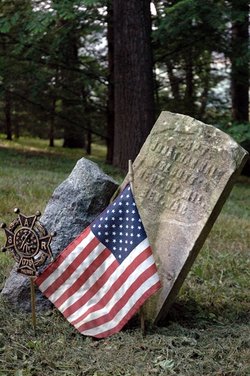In Memory of Jonathan Hale
On the night of 4 Mar 1776, the Continental Army moved onto the Dorchester peninsula and started to fortify a position on the heights.
On 5 March, the British military inside Boston started a countermove, then aborted it when the weather made an already difficult mission impossible.
On 6 March, Gen. William Howe ordered the king’s forces and Loyalists to prepare to evacuate the town.
On on 7 March, militia captain Jonathan Hale of Glastonbury, Connecticut, died in Roxbury.
Hale’s death wasn’t mentioned in any account of fighting, which leads to the conclusion that he died of illness, possibly a form of “camp fever.” He had turned fifty-five the previous month.
Capt. Hale’s body was buried in a local burying-ground later named for nearby Walter Street. The original headstone read:
The Hale grave marker disappeared by the end of that century, and the Sons of the American Revolution installed a new stone, shown above, courtesy of photographer BSN and Find a Grave.
I suspect there’s another stone memorializing Capt. Hale, in a curious way.
In the fall of 1776 the late captain’s son, also named Jonathan, did some service in the American military. I think he mobilized with a militia unit to defend either the Connecticut coast (Col. Erastus Wolcott’s regiment had that mission in late 1776) or New York City.
In September, this Jonathan Hale came back to Glastonbury. The church records record his death:
The younger Jonathan Hale’s original grave marker survives, and it says:
On 5 March, the British military inside Boston started a countermove, then aborted it when the weather made an already difficult mission impossible.
On 6 March, Gen. William Howe ordered the king’s forces and Loyalists to prepare to evacuate the town.
On on 7 March, militia captain Jonathan Hale of Glastonbury, Connecticut, died in Roxbury.
Hale’s death wasn’t mentioned in any account of fighting, which leads to the conclusion that he died of illness, possibly a form of “camp fever.” He had turned fifty-five the previous month.
Capt. Hale’s body was buried in a local burying-ground later named for nearby Walter Street. The original headstone read:
Here lyes Buried ye. Body of Capt Jonathan Hale of Glastonbury in Connecticut who dyed March 7 1776, in ye. 56 year of his age.Back in Glastonbury, this line was entered into the church records:
Capt. Jonathan Hale, died in the army at Jamaica plains, Roxbury, Massachusetts bay.In the late nineteenth century the remains of other Revolutionary War casualties, unknown soldiers who had died at the Loring-Greenough House and other army hospitals, were moved to the same cemetery, and a single memorial installed for them.
The Hale grave marker disappeared by the end of that century, and the Sons of the American Revolution installed a new stone, shown above, courtesy of photographer BSN and Find a Grave.
I suspect there’s another stone memorializing Capt. Hale, in a curious way.
In the fall of 1776 the late captain’s son, also named Jonathan, did some service in the American military. I think he mobilized with a militia unit to defend either the Connecticut coast (Col. Erastus Wolcott’s regiment had that mission in late 1776) or New York City.
In September, this Jonathan Hale came back to Glastonbury. The church records record his death:
Oct. 1, Jonathan Hale, died a few days after he returned sick from the army.A Hale genealogy also reports that the man’s teen-aged sister Jerusha died on 26 September. While the records don’t state what he died of, that’s consistent with him catching dysentery in camp and bringing it home.
The younger Jonathan Hale’s original grave marker survives, and it says:
In Memory of Mr. Jonathan Son of Capt. Jonathan & Mrs. Elizabeth Hale who died Oct. ye. 1st. AD. 1776, in ye. 31st. Year of his Age.Nearby is another Sons of the American Revolution marker that says:
Revolutionary War Capt.I suspect that latter stone mixes together the two Jonathan Hales, father and son. The father served in Wolcott’s regiment as a captain, but I see no contemporaneous record of the son being an officer. Yet that’s definitely the son’s death data. This stone thus serves as a memorial to the son’s military service, not mentioned on his own marker, and a cenotaph for the father, buried one hundred miles away.
Jonathan Hale 2d
Col. Wolcott’s Regt.
Died Oct. 1776
AE. 30.


No comments:
Post a Comment